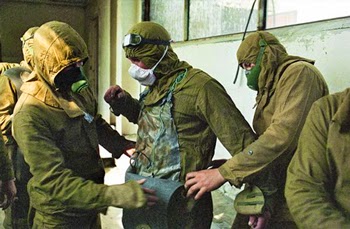< 1. Chernobyl nuclear power plant disaster >
From this time, we look about the
negative side of the information running over the world.
As we have already
seen, when the information was true, human-rights abuse was stopped, and
conflict was suppressed, and also democratization was possible by inspiring
people.
However, if that
information were distorted, what would have happened?
The news of Chernobyl nuclear power
plant disaster was typical example of manipulation of information, and the
eeriness was remarkable.
今回より、世界を巡る情報がもたらす負の側面について見ていきます。
今まで見てきたように、その情報が真実であれば、人権侵害を食い止め、紛争を抑え、さらには国民を奮起させ民主化を可能にしました。
しかし、それらの情報が歪曲されていればどうなったでしょうか?
チェルノブイリ原発事故報道は情報操作の典型例であり、その不気味さが顕著です。
< 2. Pollution
range >
In 1986, the nuclear
power plant disaster of the worst level 7 (it is the same as the Fukushima
nuclear power plant disaster) happened in the Ukraine of the Soviet Union.
The origin of the
accident was this: when conditions of low output power had occurred at the time
of a stress test, because the operating staff was panicked by it, they canceled
the safeguard and tried to return it normally.
However, the nuclear
reaction adversely was runaway, and several seconds afterward, the reactor core
melted down and exploded.
The accident cause depends on the test
having been just carried out in a structural unstable condition (defect).
But also it may be said that it was not
generated if the judgment and the handling of the control officer are right (it
is always the same).
1986年、ソ連のウクライナで最悪のレベル7(福島原発事故と同じ)の原発事故が起こった。
切っ掛けは、ストレステスト時に予想外の低出力状態になり、運転員がそれに慌てて安全装置を解除して平常に戻そうとしたことによる。
しかし逆に核反応が暴走し、数秒後に炉心が溶融し爆発した。
事故原因は、そのテストが構造上の不安定条件(欠陥)でちょうど行われたことによるが、運転の監督官の判断や対応が正しければ起こらなかったとも言える(いつも同じ)。
< 3. Worker after the
nuclear power plant disaster >
The burst size of the
radioactive material was 400 times the atomic bomb of Hiroshima.
After one day, it
arrived at Sweden on the wind, and was observed throughout the Northern
Hemisphere after half a month.
At first, the Soviet
Union government did not respond to the situation seriously, and concealed the
accident at home and abroad.
Therefore, with being defenseless, a lot
of persons that had been sent to fire fighting or restoration work got heavily
bombed.
放射性物質の放出量は広島の原爆の400倍で、1日後には風に乗ってスウエーデンに届き、半月後には北半球全域で観測された。
ソ連政府は、当初、事態を深刻に受け止めず、国内外に事故を秘匿した。
為に、消火活動や復旧工事に大量の人を送り込んだが、彼らは無防備で大量被爆することになった
< 4. changes in
thyroid disease person of neighboring country Belarus, yellow = adult, blue = young man, red= child, vertical axis
= number of patient /100000 people >
The clear damage were 33
worker's deaths at the first stage, people's migration of 130,000, and the
pollution area of 130,000㎢.
However, a large number of the diseases
and the deceased persons that were doubted of radiation exposure increased
rapidly afterwards among the associated workers or the local inhabitants.
It is assumed that the
deceased persons by the accident are from several hundred to hundreds of
thousands of people.
But, because the causal
relationship cannot be proved, the formal announcement is nothing (it is always
the same).
明確な被害は、初期に対応した33名の死亡、13万人の移住、汚染地域13万k㎡でした。
しかしその後も関連した作業者、地域住民から多数の死者や放射線被曝を疑われる病気が急増した。
事故による死者は数百から数十万人が想定されているが、因果関係を証明することが出来ず、正式な発表には至っていない(いつも同じ)。
< 5. newspaper report >
How would the world
report it?
Originally, although the truth should
have been reported, the reports were written with respective strong
speculation.
For the Soviet Union,
the accident was the biggest catastrophe.
This nuclear reactor was
an independent developmental
technique, and also government management.
The world was in the middle of the U.S.
and Russia Cold War.
Moreover, many European and American
advanced nations were promoting the nuclear power plant industry, and nuclear
power plant industry had grown in greatness.
Once, a prominent
American nuclear reactor scholar repeated theoretical calculation, and concluded,
"A nuclear power plant disaster is lower than the probability that a
meteorite will fall to Yankee Stadium."
Next time, I look at
the reports in East and West.
世界はどのように報道したのだろうか?
本来、真実が報道されるべきでしょうが、それぞれに大きな思惑が働きました。
この事故はソ連にとって動天驚地の大惨事であり、この原子炉は自前の開発技術で、国営でもありました。
世界は米ソ冷戦の最中でもありました。
また多くの欧米先進国は原発を推進しており、原発産業は巨大化していました。
かつて米国の著名な原子炉学者は理論的な確率計算を積み重ね「原発事故はヤンキースタジアムに隕石が落ちる確率よりも低い」と結論づけていました。
次回から、東西の報道を見ていきます。



































